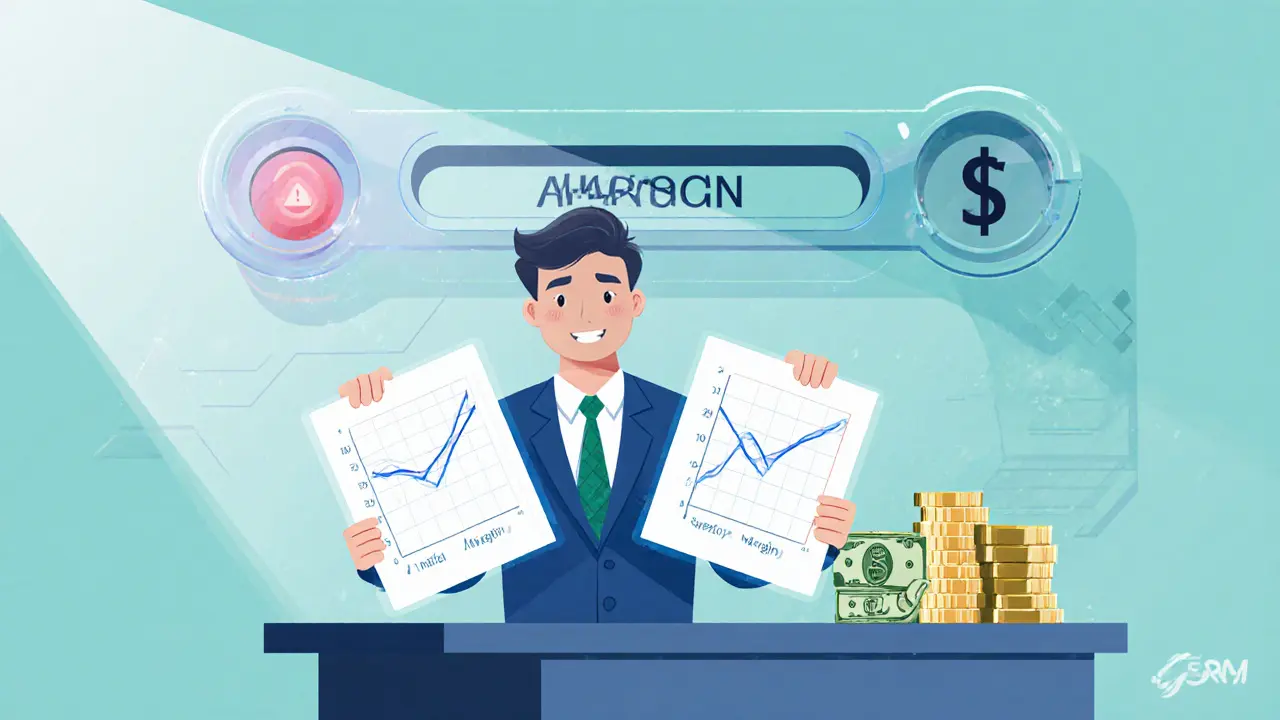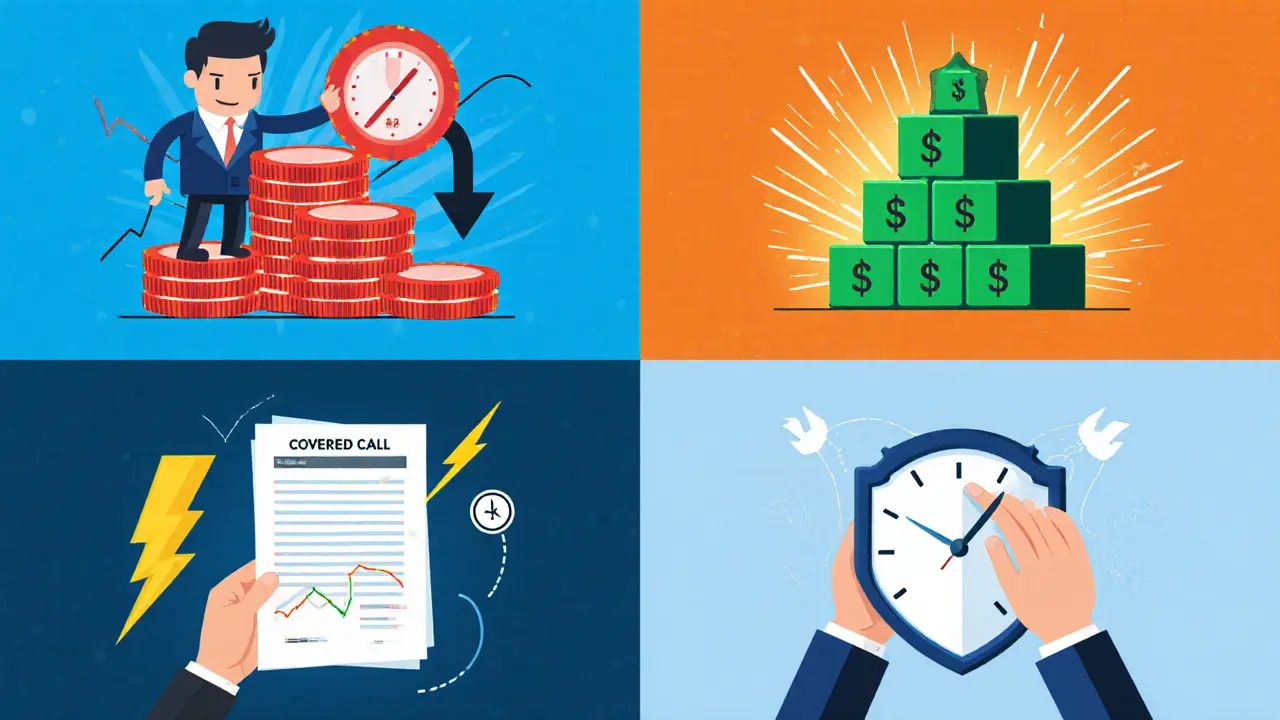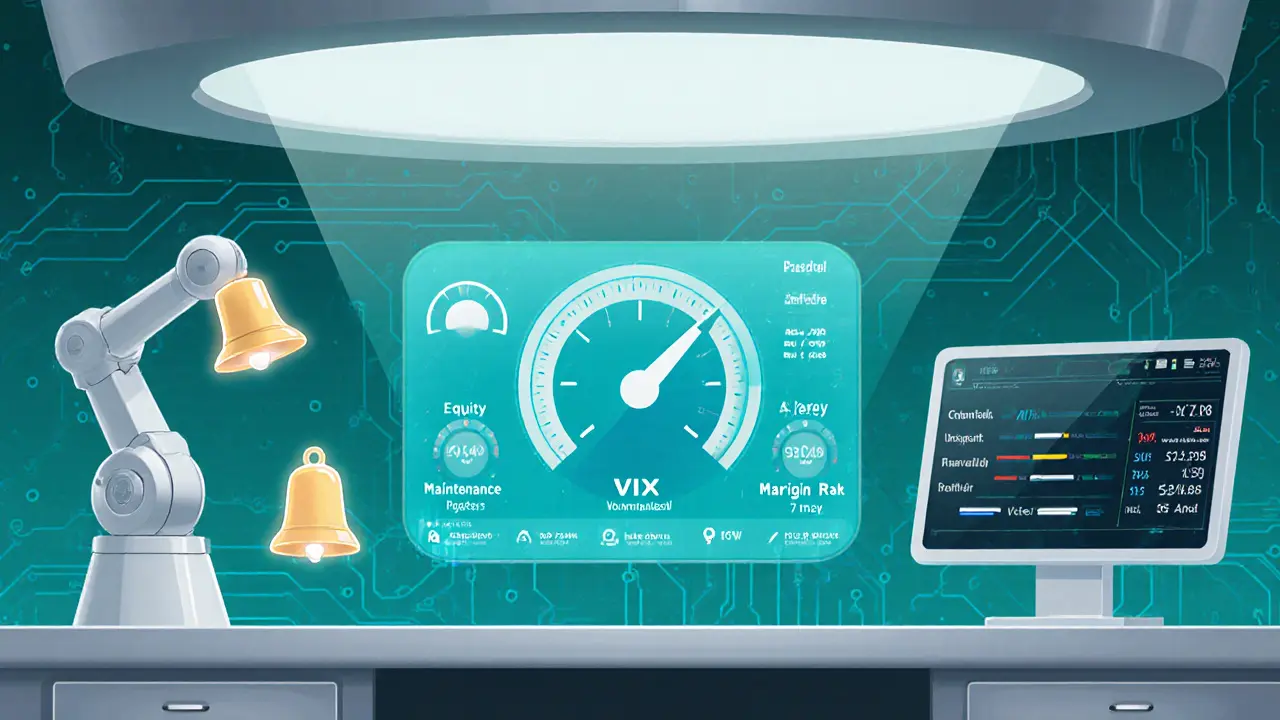Effective Margin Trading Strategies for Experienced Investors

Margin Trading Strategy Calculator
Results:
Strategy Overview
Short Selling
Best for bearish or overvalued stock scenarios. Unlimited loss potential if the stock rallies. Requires tight stop-losses and disciplined position sizing.
Key Takeaways
- Margin trading lets you double buying power, but every gain comes with a matching risk.
- Four core strategies-short selling, pyramiding, volatility/event‑driven trades, and options-fit different market views.
- Maintain a buffer above the maintenance requirement; a 2:1 leverage can turn a 5% move into a 10% loss.
- Broker choice matters: look for transparent interest rates, real‑time margin alerts, and solid educational tools.
- Automated risk‑management and regular portfolio reviews are essential for long‑term success.
When you trade on margin, you’re borrowing money from a broker to magnify your market exposure. The lure is obvious-more capital means bigger positions and the chance for higher returns. But without a clear plan, that extra leverage can also accelerate losses. This guide walks you through the most common margin trading strategies, how they work, where they shine, and the risk‑management habits seasoned traders use to stay in the game.
Understanding the Margin Framework
Before diving into any strategy, you need to grasp the three margin components that dictate how much you can borrow and when you’ll be forced to act.
Initial Margin is the minimum equity you must deposit to open a leveraged position, usually 50% of the trade’s total value under Federal Reserve RegulationT. For a $10,000 stock purchase, you’d put down $5,000 and borrow the remaining $5,000.
Maintenance Margin is the equity floor you must stay above after the trade is live. FINRA sets a baseline of 25%, but many brokers require 30‑40% for volatile securities. Falling below this triggers a margin call.
Margin Call is a broker’s demand for additional cash or securities to restore the required equity level. House calls give you five business days, NYSE calls two, and Federal calls four to meet the demand.
Core Strategies and When to Use Them
Experienced investors typically focus on four high‑impact approaches. Each has a distinct risk‑reward profile, so match the tactic to your market outlook and risk tolerance.
1. Short Selling on Margin
Short selling involves borrowing shares, selling them at today’s price, then buying them back later hoping the price drops. The profit is the price difference minus borrowing costs.
Key points:
- Unlimited loss potential-if the stock rallies, you must buy back at higher prices.
- Best for bearish or overvalued‑stock scenarios.
- Requires tight stop‑losses and disciplined position sizing.
Regulatory note: short‑sale rules, such as the “locate” requirement, still apply even when you trade on margin.
2. Margin Pyramiding
Also called “leveraged compounding,” pyramiding adds new margin‑funded positions as earlier trades become profitable. Imagine a winning $5,000 long trade that grows to $7,500; you can use the $2,500 profit plus a portion of the original equity to open a larger follow‑up trade.
Benefits:
- Accelerates equity growth when the market moves in your favor.
- Allows you to stay fully invested without pulling cash out.
Risks:
- Each layer magnifies exposure; a single reversal can wipe multiple positions.
- Requires a strict rule-e.g., never allocate more than 30% of existing equity to a new levered trade.
3. Volatility or Event‑Driven Trading
Market turbulence-earnings releases, macro data, geopolitical events-creates short‑term price dislocations. Traders use margin to capture quick moves, often entering and exiting within minutes or hours.
Typical tools:
- Intraday technical patterns (breakouts, breakdowns).
- VIX index levels as a volatility gauge; high VIX often signals more frequent margin calls.
- Scalping with tight profit targets and stop‑losses.
Because positions are short‑lived, borrowing costs are modest, but the fast‑pace demands real‑time monitoring and low‑latency execution platforms.
4. Options Strategies Within a Margin Account
Options add another dimension of leverage and risk control. Two popular margin‑friendly tactics are covered calls and buy‑write spreads.
Covered Call involves holding 100 shares of a stock and selling a call option against them. The initial margin requirement is essentially zero because the stock acts as collateral.
Buy‑Write combines a long stock purchase with a short call; brokers typically require 50% of the stock’s value as initial margin.
Advantages:
- Generates income in sideways markets.
- Limits upside but also caps downside to the premium received.
Drawbacks:
- Requires understanding of Greeks and implied volatility.
- Potential assignment risk if the stock moves above the strike price.

Risk Management Rules That Separate Winners From Losers
All four strategies share a common thread: leverage amplifies both profits and losses. Here are the non‑negotiable habits that seasoned margin traders live by.
- Never max out your margin capacity. Keep at least a 10‑15% equity cushion above the maintenance level. This buffer protects you from daily market noise.
- Use stop‑loss orders calibrated to the leverage ratio. For a 2:1 position, a 5% move against you erodes 10% of equity-set stops accordingly.
- Calculate the true cost of borrowing. Margin interest rates vary from 3% to 9% annually; factor that into your expected return.
- Monitor the margin‑call threshold continuously. Many platforms let you set custom alerts when equity drops to, say, 35% of total market value.
- Diversify across assets and strategies. A mix of short‑sell, pyramiding, and options can smooth volatility in your overall portfolio.
Choosing the Right Brokerage and Tools
Brokerage services can make or break a margin trader. Look for these features:
- Transparent interest schedule. Tiered rates based on borrowed amount help you plan costs.
- Real‑time margin‑call notifications via SMS or push alerts.
- Integrated risk‑management dashboards that show equity, maintenance margin, and projected call levels.
- Educational resources covering each core strategy. Firms like Merrill and Moomoo provide deep libraries, while discount brokers may only offer basics.
- Access to low‑latency execution for volatility trading-direct market access (DMA) can shave seconds off order fills.
Comparing the Four Core Strategies
| Strategy | Typical Market View | Leverage Effect | Risk Profile | Skill Level Required |
|---|---|---|---|---|
| Short Selling | Bearish or overvalued stocks | 2:1 (borrow shares) | Unlimited loss potential; margin call risk high | Advanced - needs fundamentals and tight stops |
| Margin Pyramiding | Strong trending markets | Compound 2:1 or higher per layer | Loss escalates with each layer; requires buffer | Advanced - disciplined scaling rules essential |
| Volatility Trading | High‑impact news, earnings, macro events | 2:1 short‑term positions | Rapid loss if price moves opposite; time‑decay short | Intermediate - real‑time monitoring critical |
| Options (Covered Call/Buy‑Write) | Neutral to mildly bullish | Effective leverage via premium income | Assignment risk; limited upside | Intermediate to Advanced - Greeks matter |

Real‑World Example: A 2:1 Pyramiding Play
Imagine you start with $20,000 cash and open a $40,000 long position in a tech ETF using 50% initial margin. The ETF jumps 8% in two weeks, pushing your position value to $43,200. You now have $3,200 unrealized profit.
Instead of cashing out, you allocate $2,000 of that profit plus an additional $1,000 of original equity to open a second $20,000 leveraged trade on a related sector index. Your total exposure is now $60,000, but equity remains $20,000 (still within a 2:1 ratio).
If the market continues upward, both legs compound, delivering outsized returns. However, a 6% drop would shave 12% off equity, potentially triggering a margin call if you’re close to the maintenance threshold. The lesson? Only pyramid when you have a clear exit plan and a built‑in equity cushion.
Future Trends Shaping Margin Trading
Algorithmic risk‑management tools are becoming mainstream. Platforms now offer automated position‑sizing that adjusts based on real‑time volatility (using the VIX or implied volatility from options). Machine‑learning models can flag when a margin level approaches a risky zone, prompting you to trim exposure before a call.
Regulatory bodies continue to monitor systemic risk. While the 25% maintenance floor remains, pattern‑day‑trader rules and potential hikes in margin requirements could affect high‑frequency strategies. Staying adaptable-by keeping a portion of your portfolio in cash or low‑margin assets-helps you weather rule changes.
Next Steps for the Aspiring Margin Trader
- Open a demo margin account with a broker that provides real‑time alerts.
- Practice each core strategy on paper for at least 30 days, tracking win‑rate and drawdown.
- Calculate your personal margin‑call buffer (e.g., aim for 35% equity when 25% is required).
- Implement a risk‑management checklist for every trade: entry, stop‑loss, position size, and exit criteria.
- Consider adding algorithmic tools that auto‑adjust position size based on the VIX or your portfolio’s volatility.
Frequently Asked Questions
What is the difference between initial margin and maintenance margin?
Initial margin is the cash you must put down to open a leveraged trade (usually 50% of the trade value). Maintenance margin is the equity floor you must stay above after the trade is live (typically 25% per FINRA, but many brokers set higher limits). Falling below maintenance triggers a margin call.
Can I short sell a stock without a margin account?
No. Short selling requires borrowing shares, which only a margin‑approved account can provide. The broker will also enforce a minimum maintenance margin for the short position.
How does the VIX index help with margin trading?
The VIX measures market volatility. High VIX levels usually mean larger price swings, increasing the chance of margin calls. Traders often use it to decide when to scale back leverage or tighten stop‑losses.
What are the typical interest rates for margin loans?
Rates vary by broker and the amount borrowed. In 2025, most major U.S. brokers charge 3%-5% for balances up to $25,000 and 6%-9% for larger loans. Always factor these costs into your expected return.
Is margin trading suitable for beginners?
Generally not. The leverage effect magnifies mistakes, and margin calls can force rapid liquidation. New investors should master cash‑only trading and risk management before adding borrowed funds.

3 Comments
Margin trading, when employed with a disciplined risk‑management plan, can significantly enhance portfolio returns. It is essential to calculate the true cost of borrowing before entering any leveraged position. Maintaining a cushion of at least ten percent above the maintenance margin helps avoid unexpected margin calls. Moreover, aligning the strategy with your market outlook-whether bearish, bullish, or sideways-ensures the leverage serves its intended purpose rather than magnifying mistakes.
Think of margin as a tool, not a crutch. When you integrate short selling, pyramiding, volatility trading, and options, you create a diversified approach that can weather different market regimes. Start with a modest leverage ratio and gradually increase as your confidence and track record grow. Always set explicit stop‑losses and revisit them after each market event.
Whoa, who thought a 2:1 leverage could turn a tiny dip into a nightmare? The article’s hype about “high‑impact” trades feels more like a daredevil invite than a solid plan. If you love watching your equity evaporate faster than a latte at 8 am, by all means, go for the pyramiding frenzy. Otherwise, maybe keep the drama on Netflix and stick to cash‑only trading.